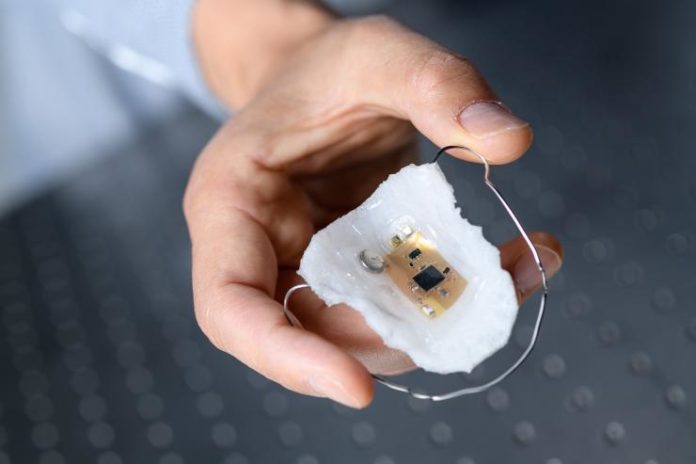Hypertension can lead to increased blood pressure and heart complications. The main cause of this includes taking too much salt. To monitor salt intake, specialists at the Georgia Institute of Technology have built up an adaptable and stretchable wireless sensing system intended to be easily worn in the mouth to gauge the amount of sodium a person expends.
The sensor incorporates a scaled-down adaptable electronic framework that utilizes Bluetooth technology to report sodium utilization to a cell phone or tablet remotely. It is based on an ultrathin, breathable elastomeric membrane.
Woon-Hong Yeo, an assistant professor in the Woodruff School of Mechanical Engineering at the Georgia Institute of Technology, said, “We can unobtrusively and wirelessly measure the amount of sodium that people are taking in over time. By monitoring sodium in real-time, the device could one day help people who need to restrict sodium intake and learn to change their eating habits and diet.”

The device has been tested in three adult study participants who wore the sensor system for up to a week while eating solid and liquid foods, including vegetable juice, chicken soup, and potato chips. Scientists suggest the device could be used for many different goals involving eating behavior for diet management or therapeutics.
Sodium sensors are available commercially, but Yeo and his collaborators developed a flexible micro-membrane version to be integrated with the miniaturized hybrid circuitry. The flexible design began with computer modeling to optimize the mechanical properties of the device for use in the curved and soft oral cavity. The researchers then used their model to design the actual nanomembrane circuitry and choose components.
Yeo reported, “The entire sensing and electronics package was conformally integrated onto a soft material that users can tolerate. The sensor is comfortable to wear, and data from it can be transmitted to a smartphone or tablet. Eventually, the information could go a doctor or other medical professional for remote monitoring.”
The next steps for the sodium sensor are to miniaturize the device further and test it with users with medical conditions to address hypertension, obesity, or diabetes.
The researchers would like to do away with the small battery, which must be recharged daily to keep the sensor in operation. One option would be to power the device inductively, replacing the battery and complex circuit with a coil that could obtain power from a transmitter outside the mouth.
In addition to Yeo, the paper’s authors include Yongkuk Lee, Saswat Mishra, and Musa Mahmood of Georgia Tech; Matthew Piper, Youngbin Kim, Connor Howe, Dong Sup Lee, Katie Tieu, James Coffey and Richard Costanzo of Virginia Commonwealth University; Hun-Soo Byun of Chonnam National University in Korea, and Mahdis Shayan and Youngjae Chun of the University of Pittsburgh.
Journal Reference
- Lee, Y., Howe, C., Mishra, S., Lee, D. S., Mahmood, M., Piper, M., Kim, Y., Tieu, K., Byun, H., Coffey, J. P., Shayan, M., Chun, Y., Costanzo, R. M., & Yeo, W. (2018). Wireless, intraoral hybrid electronics for real-time quantification of sodium intake toward hypertension management. Proceedings of the National Academy of Sciences, 115(21), 5377-5382. DOI: 10.1073/pnas.1719573115
